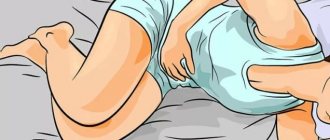Common symptoms such as malaise, vomiting, loose stools and abdominal pain are characteristic of a gastrointestinal disorder. If these symptoms occur, it is advisable to visit a gastroenterologist. Timely diagnosis, tests and consultation with a doctor will help avoid the development of serious pathology. Abdominal pain in combination with other symptoms is an alarming sign that cannot be ignored.
Food poisoning
Improper storage or preparation of food causes spoilage. Vegetables and fruits that were grown using large amounts of nitrates and fertilizers are put on sale. Animal meat can also contain substances that cause poisoning if chemical feed is given to animals.
Poisoning from poor quality food
Damage to the digestive system occurs in almost all food poisoning. The patient begins to experience abdominal pain, nausea, and diarrhea. Vomit has a specific smell and color. If the poisoned person has bleeding in the esophagus and stomach, the vomit becomes pink or black.
Botulism toxin poisoning
Botulism bacteria, whose waste products are poisonous, can multiply in spoiled canned food. Botulism toxins are formed in fish, legumes, and canned meat. There have been documented cases of botulism caused by honey consumption. Products in which bacteria live do not show external signs of any spoilage.
A sign of poisoning is vomiting, the victim begins to experience colic, stomach pain and diarrhea. The patient feels lethargic, weak, and weak. During the first day, the temperature can rise to 40 degrees, but subsequently becomes lower. Then the patient’s vision, swallowing, speech, breathing are impaired, motor functions are impaired, and death can occur as a result of poisoning.
Mushroom poisoning
Mushroom poisoning is very difficult, since mushroom poisons are slowly eliminated from the body. So, in case of poisoning with toadstool
after a few hours, colicky pain in the stomach begins, profuse diarrhea with the smell of rot, and uncontrollable vomiting. There are traces of blood in the stool. After 2 or 3 days the victim will feel better. But this is an apparent improvement, since afterwards disturbances in the functioning of the liver, heart and other organs may appear and the patient may fall into a coma.
When eating fly agarics
The victim experiences stomach pain, vomiting, and profuse diarrhea. These symptoms occur along with drooling and sweating. The patient's pupils constrict. These are the first signs of poisoning. In the future, convulsions and brachycardia, exotoxic shock may appear.
In case of food intoxication it is necessary:
- rinse the stomach with warm water;
- take any sorbent (activated carbon, Enterosgel, Smecta);
- drink plenty of water;
- call a doctor to your home.
Chemical poisoning
In case of poisoning with household alkalis
(caustic soda, slaked lime, ammonia water) the victim experiences bloody vomiting, diarrhea with bloody mucus, pain in the lower abdomen, burns of the mucous membranes of the mouth, esophagus and stomach. In case of poisoning, tissue perforation may occur.
In case of acid poisoning
, used in everyday life (vinegar, salt, concentrated lemon), the main symptom is damage to the mucous membranes of the mouth, esophagus and stomach. Diarrhea is not one of the main signs of damage.
Household organophosphates
are insecticide preparations (Iskra, Inta-Vir, Karbofos, Micron, Metaphos, Dichlorvos and others) used to control insects.
You can be poisoned by insecticides when treating your garden. The victim may have not only severe pain in the lower abdomen, but also nausea and diarrhea. A poisoned person experiences dizziness, anxiety, and headache. His pupils are constricted, breathing is difficult, and pulmonary edema may begin.
Intestinal infections
Many infectious intestinal diseases are accompanied by nausea, upset stomach and pain. Loss of fluid and salts can lead to serious consequences.
Intestinal (rotovirus) infection
The disease is common among children attending kindergartens and among primary schoolchildren. The patient develops a fever, diarrhea, nausea, pain in the lower abdomen or over the entire surface, watery eyes, redness and pain in the throat, and bloating. Stool with rotavirus infection is grayish, clay-like, blood and mucus may appear in it, and gases have a putrid odor. The patient's urine is dark and has an unpleasant odor, while the feces, on the contrary, are light. Diarrhea continues for more than one day. The patient's feces contain undigested foods: fat, plant fibers, protein.
With a rotavirus infection, not one family or team member becomes infected, but several, one after another. The diagnosis is made by the attending physician based on a biochemical blood test. At the beginning of the disease, the white blood cell count is elevated, but at the height of the disease, the red blood cell count drops below normal. Analysis shows high nitrogen content. The immunofluorescence method allows you to detect the virus that causes the disease, and the RSC method allows you to detect antibodies.
The patient is prescribed a diet. Milk and all dairy products, including butter and foods high in carbohydrates, are excluded from the diet. The doctor prescribes regindon, drinking plenty of fluids, including fruit drinks and compotes, sorbents, Mezim, Creon.
Dysentery
The causes of the disease are bacteria of the genus Shigella, which multiply in water, dairy products, vegetables, berries and fruits. Dysentery is characterized by pain in the lower abdomen, frequent, very loose stools mixed with mucous mass and blood. The patient constantly feels false urges, abdominal pain, and in severe cases of the disease he may vomit.
Dysentery is easy to infect other people. The diagnosis is made in the infectious diseases department of the hospital. To do this, a stool sample is cultured in a bacteriological laboratory. This method confirms dysentery in 60% of cases. Accelerated analysis methods are also used, which can detect bacteria in urine, saliva, blood and feces.
Dysentery is treated in a hospital. The patient is prescribed a diet that excludes foods that irritate the stomach and intestines. The diet includes foods containing astringents. The doctor also prescribes antibiotics in the form of injections and other antibacterial drugs: fluoroquinolones, aminoglycosides, cephalosporins, ofloxacin, ciprofloxacin and others.
Salmonellosis
This disease is caused by bacteria of the genus Salmonella. The source of bacteria is animals and birds, their feces, milk, meat, chicken and other bird eggs. A person can become infected through a sick person, or through a healthy person who is a carrier of the infection.
There are several forms of the disease. Gastrointestinal, the most common form, begins suddenly. The sick person develops a fever and diarrhea. Pain in the abdominal cavity is concentrated mainly near the navel. Then painful vomiting begins, in which pieces of food and bile are present.
Toxic infection
The reason why a person simultaneously has a headache, a stomach ache and at the same time feels sick can be a toxic infection. Disease provocateurs can be staphylococcus, salmonella, clostridia and botulism.
Staphylococcal infections
Signs of the disease are few, but characteristic. This:
- abdominal pain localized in the epigastric region;
- attacks of nausea and vomiting;
- a significant decrease in blood pressure, which causes the development of headaches.
The acute period of infection with staphylococci lasts no more than a day. Then the patient's general condition stabilizes. But over the next few days he feels general weakness and feels dizzy. The basis of treatment of the disease is the suppression of the vital processes of staphylococci. For this purpose, drugs from the antibiotic category (penicillin group) are often used.
Clostridia
Infection with clostridia occurs with more pronounced and severe clinical symptoms. Signs of infection include:
- headaches/stomach pains becoming more intense;
- Frequent diarrhea causing dehydration.
Treatment of the disease is carried out in a hospital setting under the supervision of doctors. The patient receives drugs that suppress further development of the infection intravenously.
Salmonellosis
Salmonellosis is very difficult. The following signs are typical for it:
- sharp pain in the abdomen;
- the intestines constantly “twist”, the person develops severe diarrhea;
- uncontrollable vomiting;
- worsening headache;
- feverish conditions, chills;
- dizziness;
- muscle spasms;
- aches throughout the body;
- development of seizures.
When such symptoms develop, suggesting the development of salmonellosis, the person is subject to urgent hospitalization in the infectious diseases department.
Botulism
Penetration of botulism bacteria into the human body - in the absence of adequate therapy - can cause death. The clinical picture develops as follows. The patient develops headaches and stomach pain, severe diarrhea and uncontrollable vomiting.
Diseases of the stomach and duodenum
Gastritis
Gastritis is an inflammatory dystrophic disease of the stomach, caused by infection with the bacterium Helicobacter pylori. The main symptoms are stomach pain, belching, heartburn, vomiting, diarrhea or constipation, flatulence.
Gastritis pain is aching, it occurs about 20 minutes after eating and lasts about 2 hours. The feeling of fullness in the stomach persists for several hours. Pain also occurs during stressful situations and when smoking on an empty stomach. Pain is localized in the upper abdomen.
You may also feel nauseous before eating. Morning vomit may taste sour. Stool with diarrhea has an acidic odor.
Gastritis is treated by prescribing a special diet, taking enterosorbents, antispasmodics, Omez; in case of bacterial inflammation of the intestinal walls, the doctor may prescribe antibiotics.
Stomach ulcer
This is a chronic disease in which ulcerative defects form on the mucous membranes of the stomach. The main symptom of peptic ulcer disease is aching pain in the abdomen that occurs before or after eating. The pain is localized in the middle part of the abdomen, or slightly to the left of center. During an exacerbation, patients constantly vomit with a sour taste.
With ulcers with high acidity, patients experience constipation. Diarrhea with ulcers occurs periodically, but they do not belong to the “classical” signs of this disease, as they arise due to dietary errors and increased irritability of the stomach walls.
Treatment of stomach ulcers includes following a therapeutic diet, taking antispasmodics, painkillers, and medications that destroy Helicobacter Pylori bacteria.
Duodenal ulcer
With a duodenal ulcer, pain is associated with food intake, pain is localized at a distance of 1-2 cm to the right of the midline of the abdomen, occurs in a state of hunger and disappears after the patient eats. Pain, moderate to severe, also occurs after physical work and exercise, after eating fatty, fried, spicy, salty foods. The disease is characterized by belching, nausea, frequent heartburn, and vomiting.
The disease is accompanied by diarrhea or constipation. In the acute form of the disease, blood, mucus, pus, and an unpleasant odor appear in the stool. The patient's blood pressure is low.
For this disease, adherence to a therapeutic diet and physiotherapeutic procedures are indicated; in case of danger of perforation of the ulcer, surgery is necessary.
When to Call Emergency Help
Pain in the gastrointestinal tract can occur for various reasons. Pain is usually accompanied by symptoms such as vomiting, nausea, chills, and diarrhea. Many people cope with such symptoms on their own, but it is important to understand that quality treatment can only be obtained with a reliable diagnosis, which can only be determined by a qualified doctor.
Clinical picture
In order for the doctor to be able to establish the cause of the pathological condition, it is necessary to pay attention to the location of the pain, as well as the accompanying symptoms.
Nausea, loose stools and a state of weakness throughout the body are often accompanied by belching and sharp pain in the lower abdomen. This is how the symptoms of gastritis, chronic pancreatitis, and cholecystitis manifest themselves.
With gastritis, even a violation of the usual diet can provoke unpleasant symptoms. Even eating fresh fruit can cause irritation of the mucous membrane - hard fibers damage it. You can often feel nauseous after eating. Vomiting can quickly relieve the condition.
Similar signs may appear in an adult during an exacerbation of peptic ulcer disease. However, diarrhea with such diseases is rare. Exacerbation of stomach ulcers occurs in spring or autumn for no apparent reason. The pain often radiates to the back. Nausea, weakness and pain are the main causes of ulcers.
The appearance of dagger pains is a serious sign of the development of a complication of peptic ulcer disease - perforation of the stomach wall. In addition, dizziness and vomiting may occur. Weakness can be caused by bleeding, so treatment is carried out promptly.
Also, similar symptoms appear in women during the premenstrual period, at the initial stage of pregnancy, with brain injuries, and in adults with stress and neuroses.
Poisoning can be mild, which can be treated at home, or severe, which will require immediate medical attention.
convulsions; fainting; pain when going to the toilet; constant incessant vomiting. cardiopalmus; constant thirst and dry skin; low pressure; profuse and frequent diarrhea with pain; chapped lips.
The presence of even one of these signs is the reason for calling an ambulance. Before her arrival, it is necessary to rinse the patient’s stomach and provoke an attack of vomiting. He also needs to be given plenty of water and ensure peace.
Diseases of other organs
Abdominal form of myocardial infarction
With the abdominal form of a heart attack, a person experiences very strong pain in the right hypochondrium and on the right side of the abdomen. Burning pain is not relieved by taking painkillers or nitroglycerin. A heart attack is accompanied by impaired intestinal motor activity (peristalsis), increased blood pressure, flatulence and bloating, tachycardia, nausea and vomiting, and diarrhea.
Colitis
Colitis is an inflammatory disease of the mucous membrane of the large intestine. In acute colitis, pain in the lower abdomen and in the middle part is characterized by a sharp, cramping nature, accompanied by frequent nausea, vomiting, and diarrhea.
The patient feels a painful false urge to defecate. The feces contain undigested food, pus, bloody mucus and have a putrid odor. Bowel movements can occur up to 20 times a day. The patient suffers from bloating.
In chronic colitis, the symptoms of the disease are more pronounced, since not only the mucous membranes, but also the ligamentous-muscular apparatus are involved in the inflammatory process.
Pancreatitis
With pancreatitis, severe pain can be girdling, can be localized on the right or left under the ribs, in the pit of the stomach, and involve the lower abdomen. If you tolerate it, a painful shock may occur. Hiccups, frequent nausea and vomiting with bile, belching, dry mouth are constant symptoms of pancreatitis. There are pieces of food in the vomit.
The patient may experience constipation with bloating or diarrhea. The stool with diarrhea is foamy and contains pieces of undigested food. The feces have an unpleasant, foul odor.
Other symptoms of pancreatitis include shortness of breath, bluish skin on the lower back and around the navel, yellowing of the skin and sclera. The face, pale at the beginning of the disease, later acquires a gray-brownish color.
Inflammatory and destructive diseases of the abdominal organs
Appendicitis
The cause of an attack of appendicitis is an inflammatory process in the vermiform appendix of the large intestine. The most dangerous consequence of such inflammation is peritonitis. Acute appendicitis begins with pain above the navel or in the solar plexus. Then it quickly moves to the right iliac region, pain appears in the lower abdomen and other areas. The pain may subside when the body is stationary, but intensifies with any movement.
Vomit in acute appendicitis contains bitter bile. The patient's body temperature may rise to 38 degrees. During an attack, constipation or, conversely, diarrhea may occur, the patient often urinates, and the urine is usually dark in color.
Ectopic pregnancy
As is clear from the name of the disease, its cause is the development of the fetus outside the uterine cavity. As the embryo develops, the main symptom of an ectopic pregnancy is pain in the pelvic region, often on one side of the abdomen. The lower abdomen hurts slightly at first, then the pain becomes strong and cramping. The pain can radiate to the anus, neck, spine, shoulder. Pain is present during bowel movements and urination.
With an ectopic pregnancy, vomiting and diarrhea often occur, similar in nature to those that occur with poisoning from poor-quality food. Another sign of the disease is vaginal bleeding not associated with the menstrual cycle. The blood is red or dark.
Rules for dealing with pain, vomiting and diarrhea
- drink plenty of fluids;
- eat light food.
- eat fatty and spicy foods;
- take pills and medicines without a doctor’s prescription;
- endure severe pain.
Timely medical attention will help to correctly diagnose indigestion and pain. The use of folk remedies without consultation with specialists is unacceptable.
By using this site, you agree to the use of cookies in accordance with this cookie type notice. If you do not agree to our use of this type of file, you should set your browser settings accordingly or not use the site.
If a person has diarrhea, feels sick, feels dizzy and has a stomach ache, this does not always indicate the development of gastrointestinal pathologies. For an accurate diagnosis, you need to compare additional symptoms and be sure to consult a doctor. It is also important to follow first aid rules and be aware of dangerous symptoms that can pose a threat to life.
Traditional methods of treatment
For any intestinal disorder, there are many very effective folk remedies to get rid of diarrhea and stomach pain:
- You need to take 5-7 pieces of black peppercorns with water, without chewing;
- Take a tablespoon of potato starch with a glass of boiled water;
- Pour 50 grams of dry sage with half a liter of boiling water. Leave for about an hour. Strain through cheesecloth. Mix with two glasses of red wine. Drink 200 mg every two hours;
- Take 1 tablespoon of tea leaves with water;
- Pour 2 tablespoons of water into a glass. pomegranate peel. Boil for 30 minutes. Strain with gauze. Drink 1-2 tablespoons half an hour before meals;
- A spoon of oak bark is poured with 2 glasses of vodka. Leave for 5–7 days. Take 15–20 drops, no more than twice a day;
- Pour crushed chamomile (1 tbsp) with vodka (0.2 liters). Mix with 2-3 tbsp. spoons of honey. Leave for 10–14 days. At the same time, everyone needs to shake the container. Strain. Drink 15 ml before meals, no more than three times a day;
- Pour 1 cup of fried seeds into 0.5 liters of boiling water and keep on fire until half of the water has evaporated. Strain. Adults – 0.5 cups, children – one spoon.
Pathological causes of pain and nausea
The most common factors that cause discomfort include:
- Poisoning. Associated with the consumption of expired or low-quality products. Chemical intoxication can occur due to the abuse of vegetables and fruits high in nitrates. Then the person’s temperature rises, heaviness appears in the epigastric zone, and most often diarrhea occurs. After cleansing the body, the symptoms disappear. The most severe is mushroom poisoning, which is combined with bloody diarrhea. In this situation, you need to call a doctor. Sometimes poisoning occurs due to taking medications.
- Intestinal infections. In most cases, they are accompanied by severe vomiting and diarrhea, as well as general weakness. With rotavirus, which affects children, there is mucus and blood in the stool. And with dysentery, multiple white stools often appear - up to 50 times a day, and the temperature rises. Another common infection is salmonellosis, which can be contracted from humans and animals. It develops rapidly, with fever, pain and diarrhea.
- Colds. In some patients, pain, nausea and diarrhea are observed with ARVI. The temperature rises to 37-37.5 degrees. Symptoms are often associated with viral infections and weak immunity.
The largest group of causes of diarrhea, weakness, nausea, fever and abdominal pain are gastrointestinal diseases.
Pathologies of the intestines and stomach
Disturbances in the gastrointestinal tract are associated with chronic and acute forms of diseases:
- Gastritis. Nausea and pain appear during exacerbation of the disease, which is caused by infections, poor diet, stress and incorrect medication. In addition to pain, diarrhea, burning in the sternum, and belching after eating appear. Symptoms are localized in the upper abdomen.
- Ulcer. A chronic pathology that is difficult to cure. The pain of an ulcer is severe, acute, making it impossible to do normal activities. Vomiting occurs during an exacerbation.
- Colitis. A disorder associated with inflammation of the small intestine. The pain is localized in the lower abdomen, constipation and diarrhea, and weakness often appear. After defecation, the patient feels relief.
- Inflammation of the pancreas. Symptoms occur on the left or right in the hypochondrium, sometimes covering the lower abdomen. Acute pain can lead to loss of consciousness. Not all people develop vomiting, fever and heartburn.
- Appendicitis. An acute surgical condition associated with inflammation of the appendage of the cecum. The pain is diffuse, appears in the navel area and moves to the right. Diarrhea and vomiting often occur, and the temperature rises to 39-40 degrees.
- Lactose intolerance. It develops in people from birth, as well as in old age. After eating foods, bloating and gas formation begins, diarrhea and vomiting appear. The pain is localized just above the navel or to the left.
Gastrointestinal diseases also include dysbiosis, which can be caused by poisoning, antibiotic use, poor diet and chronic diseases. The pain is moderate, often located in the lower or upper abdomen. Dysbiosis causes bad breath, heartburn, heaviness, belching and flatulence.
Pathologies not related to the stomach and intestines
In many patients with cardiac disorders, diarrhea and abdominal pain are associated with exacerbation of the disease, as well as with infarction, ischemia, and acute heart failure. The pain is cutting and sharp and is always located in the upper abdomen. Dizziness also appears, loss of consciousness, shortness of breath, swelling, and lack of air are possible.
Prevention
Preventive measures include eating only fresh foods. It is also necessary to maintain hygiene during cooking and storing food. It is important to be vigilant towards children and pay attention to the color and smell of food.
Canned food should emit a characteristic pop when opened - this indicates the tightness of the container being opened.
In order to avoid pain and nausea, you must:
- Monitor proper and balanced nutrition.
- Do not abuse alcohol and tobacco products. They can cause ulcers and many other disorders.
- Timely health diagnostics.
- Active lifestyle.
If you follow all the rules, you will save yourself from unnecessary problems and maintain the health of your organs for many years.
Be sure to watch the next video
Note!
The presence of symptoms such as:
- Stomach ache
- smell from the mouth
- heartburn
- diarrhea
- constipation
- belching
- increased gas formation (flatulence)
If you have at least 2 of these symptoms, then this indicates a developing
gastritis or ulcer.
These diseases are dangerous due to the development of serious complications (penetration, gastric bleeding, etc.), many of which can lead to
LETHAL
outcome. Treatment needs to start now.
Read the article about how a woman got rid of these symptoms by defeating their main cause using a natural method. Read the material…
Nausea, dizziness, weakness and abdominal pain can have a variety of causes. Ignoring symptoms can lead to serious consequences. It is necessary to determine the cause of the ailment and assess the general condition of the patient.
If poor health is caused by overwork, stress or weather changes, you can get by with treatment at home. Medical intervention is necessary if serious chronic or infectious diseases are suspected. Also when the patient’s condition rapidly deteriorates.
Methods for diagnosing the condition
Since the causes of abdominal pain, diarrhea and nausea are different, diagnosis requires an integrated approach:
- when visiting a doctor, the patient describes all the existing symptoms: the characteristics of their manifestation, the presence of impurities in feces and vomit, the duration of symptoms, dietary habits and the presence of diseases;
- after drawing up the clinical picture, the doctor gives a referral for laboratory tests, the main one of which is stool analysis;
- An ultrasound or x-ray will be required; if there is insufficient data, an MRI or CT scan will be prescribed.
In acute conditions, endoscopic examination of the stomach and intestines is not prescribed.
Warning signs and emergency consultation with a doctor
Call an ambulance immediately if the following symptoms accompany nausea and diarrhea:
- dry skin, pallor;
- stool more than 10 times a day;
- fever and increased temperature;
- severe and regular vomiting;
- weakness, fainting;
- blood in stool or vomit;
- unbearable abdominal pain.
All this indicates the development of dangerous pathologies requiring surgical intervention.
If acute symptoms are ignored, they can lead to peritonitis and other dangerous diseases that are incompatible with life.
If these symptoms are caused by a gastrointestinal disease
Next, we consider the main pathologies requiring surgical intervention and their symptoms.
Appendicitis
Inflammation of the appendix of the cecum. There are many reasons why the inflammatory process begins: blockage of the lumen of the appendix (stones, helminths, tumors, etc.), disruption of blood microcirculation in the organ.
Also, poor nutrition (eating food that slows down intestinal motility, as a result of which feces stagnate in the intestines), allergies, and a tendency to constipation. The symptoms of appendicitis are the same in 95% of cases: pain in the lower abdomen, mainly on the right, nausea, vomiting, diarrhea. The temperature can reach up to 38 degrees or not rise at all.
Pancreatitis
Inflammatory disease of the pancreas. There are many causes of inflammation of the endocrine gland: alcohol abuse, fatty, smoked, fried foods, diseases of the stomach and duodenum, cholelithiasis.
Previous infectious pathologies, taking certain medications (antibiotics, glucocorticosteroids), abdominal injuries and allergies can also trigger the onset of the inflammatory process.
The clinical picture is expressed:
- severe girdle pain;
- nausea and vomiting that does not bring relief;
- a slight increase in body temperature in adults and above 38 degrees in children.
Diarrhea may be replaced by constipation, severe weakness, increased fatigue, and bloating appear. Treatment of pancreatitis is carried out under the strict supervision of a doctor in a hospital. An important condition on the path to recovery is diet, taking anti-inflammatory and antispasmodic drugs.
Features of the treatment of abdominal pain and diarrhea
Since the symptoms can be caused by dangerous conditions, you cannot independently treat them with medications that dull the pain. The only thing the patient can do is calm down, lie down and drink water in small portions.
The treatment method for abdominal pain, diarrhea and vomiting in adults depends on the identified disease. If this is poisoning, you must do the following:
- remove toxins from the body by diluting potassium permanganate in a glass of water until pale;
- take medications after cleansing with potassium permanganate, sorbents are usually used: activated carbon, 1 tablet per 10 kg of patient weight, or Enterosgel, Polysorb;
- Drink plenty of fluids to prevent dehydration - drink unsweetened compotes, water or Regidron solution.
After the condition has normalized, the patient should take a course of probiotics that restore the intestinal microflora. If poisoning is caused by microorganisms, antibiotics are prescribed.
For gastrointestinal diseases, medications are prescribed aimed at eliminating the symptoms and causes of the disorder. For gastritis, drotaverine is often used to relieve spasms, as well as Omeprazole to prevent the action of hydrochloric acid.
Folk remedies for pain and diarrhea
Some natural products will help cope with the symptoms of poisoning and temporary disruption of the gastrointestinal tract:
- brewed pomegranate skins - the dried peel is crushed and poured with 1 glass of boiling water, drunk at the first symptoms for at least 5 days;
- ginger root - can be eaten in the absence of gastritis, as well as drink tea;
- dried blueberries – 1-2 tsp. Brew with boiling water and take for diarrhea.
To prevent gastrointestinal pathologies and poisoning, it is important to follow a diet, not overeat, give up bad habits and avoid consuming low-quality or expired products. Regular physical activity strengthens the immune system and improves digestion. Prevention methods also include the need for heat treatment of all meat and fish products. Fruits and vegetables should be washed with soap before consumption.
Ivanova Svetlana
General practitioner of the second category, transfusiologist, 29 years of experience
Diagnosis and treatment of problems with the musculoskeletal system (lower leg) and abdomen.
- pain and discomfort in the abdomen;
- bruises and injuries of the lower leg;
- cough, chest pain;
- acute respiratory infections, ARVI;
- food poisoning;
- cold;
- runny nose;
- general malaise;
- headache;
- aching joints;
- elevated temperature.
- Diploma in the specialty “General Medicine (Treatment and Prevention)”, Chuvash State University named after. I.N. Ulyanova, Faculty of Medicine (1990)
- Internship in the specialty “Selected Issues of Therapy”, Kazan State Medical Academy (1996)
Refresher courses
- “Nephrology issues for therapists”, State Institute for Advanced Training of Physicians named after V.I. Lenin (1995)
- “Therapy”, Kazan State Medical Academy (2001)
- “Transfusiology”, Russian Medical Academy of Postgraduate Education of the Ministry of Health of the Russian Federation (2003)
- “Therapy and Pulmonology”, St. Petersburg Medical Academy of Postgraduate Education of the Federal Agency for Health and Social Development (2006)
- “Transfusiology”, St. Petersburg Medical Academy of Postgraduate Education of the Federal Agency for Health and Social Development (2007)
- “Transfusiology”, Institute for Advanced Medical Studies of the Ministry of Health and Social Development of Chuvashia (2012)
- “Therapy”, Institute for Advanced Medical Studies of the Ministry of Health and Social Development of Chuvashia (2013)
- “Therapy”, Peoples' Friendship University of Russia (2017)
Place of work: MedCenterService clinic on Kurskaya
If you have stomach pain or diarrhea, you should consult a doctor. It is quite difficult to independently determine the causes of such health problems.
Diarrhea and abdominal pain may be symptoms that indicate a disorder in the functioning of the digestive system, or may simply occur due to overeating or stress. Even simple physical stress can cause nausea and abdominal pain.
Sometimes these unpleasant symptoms appear unexpectedly for a person and also disappear unexpectedly for him, without any treatment. However, things don't always end so well. Often the patient requires medical attention.
First aid
All of the above clinical manifestations occur against the background of various diseases. Before starting a course of treatment, you should visit a doctor, take tests and undergo a full examination. Once your doctor makes a diagnosis, you can begin the prescribed treatment. You should not self-medicate, as many diseases occur with similar symptoms. Self-prescription of medications can aggravate the course of the disease.
To get rid of signs of gastrointestinal disease, you can drink activated charcoal. The dosage is as follows: per 10 kilograms of weight - 1 tablet of coal. It has an absorbent property, thanks to which it easily absorbs pathogenic elements and removes them from the body.
It is also recommended to drink saline solutions. Thanks to these medications, salt balance is restored and dehydration is prevented. Painful sensations can be eliminated with the help of antispasmodics such as No-Shpa, Spazmolgon.
If you have suspicious symptoms, it is advisable to call an ambulance. The doctor will be able to determine the cause of the pathology and prescribe therapy, which will be much more effective than self-medication.
Nausea, diarrhea and stomach pain - what does this mean?
Nausea, diarrhea and stomach pain are a triad of symptoms that most often characterize disorders of the digestive system. Even minor disruptions in the functioning of the gastrointestinal tract can lead to loose stools and other unpleasant symptoms. Pain may be a sign of some pathology, or indicate a developing complication. When the gastric mucosa is inflamed (gastritis), the pain is burning and cutting, but it can be tolerated. While a stomach ulcer is accompanied by extremely intense pain.
With gastritis with low acidity, a person will experience heaviness in the epigastric region. With pyloric stenosis, this zone seems to be bursting from the inside.
Pathologies accompanied by symptoms
Nausea, vomiting, and diarrhea can be caused by various pathologies of the gastrointestinal tract and disorders of the digestive system, including:
- Food poisoning.
- Intestinal infections.
- Chronic pathologies of the gastrointestinal tract.
- Inflammatory diseases of organs.
Often similar symptoms are observed in girls in the first trimester of pregnancy. In rare cases, they indicate serious pathologies.
Eating foods of poor quality and products that have expired, as well as those with a high content of nitrates, can be fraught with poisoning. A person's temperature can rise to 38 degrees. Abdominal pain may be accompanied by a painful sensation in the epigastric region and vomiting. Diarrhea occurs. Symptoms usually disappear after the body has completely rid itself of toxins.
In case of mushroom poisoning, the patient’s condition worsens after a couple of hours and is accompanied by severe uncontrollable vomiting, stomach cramps and bloody diarrhea. In case of such poisoning, you need to rinse your stomach and call a doctor. The consequences of intoxication can be the most severe.
In case of poisoning with highly toxic substances, disturbances in the functioning of the central nervous system are detected. The patient has hallucinations and lacks coordination.
Most intestinal infections are accompanied by stool upset, vomiting, abdominal pain and general weakness of the body.
Rotavirus infection is common among children and children of primary school age. The patient's stool is loose, mixed with mucus and blood, has a grayish tint, there is pain in the abdomen, and the temperature rises. The disease often occurs with headache. The danger of rotavirus infection is the ability to quickly pass from one member of a team to another.
Dysentery is an acute intestinal infection, which is characterized by pain in the lower abdomen, severe diarrhea with blood and mucus. The patient feels weak and nauseated. The infection must be treated in a hospital setting.
Salmonellosis is a serious intestinal infection, the carrier of which can be a sick person or a healthy person who is a carrier of the infection, as well as birds and animals. Symptoms come on suddenly. First, the body temperature rises, then diarrhea begins, and the stomach hurts. The patient is shivering. After a while, severe vomiting develops.
Early toxicosis is a common phenomenon in pregnant women. More often caused by neuroendocrine disorders. A woman’s body is subject to physiological changes and cannot adapt normally to pregnancy, which is why toxicosis occurs. Manifests itself in the form of vomiting. Rarely, diarrhea may occur. Weakness appears and blood pressure drops.
Main causes of these symptoms
The reasons that lead to abdominal pain, diarrhea and vomiting can be very diverse. Depending on the etiological factor, a decision will be made to carry out therapy at home, or to consult a doctor.
Food poisoning
Food poisoning causes indigestion. Eating stale or low-quality foods leads to this disorder. The pain of food poisoning is sharp, most often cutting. The person becomes very sick and may experience vomiting and diarrhea. There are often blood impurities in the vomit, there is no appetite, and the head begins to hurt badly. Body temperature rises to significant levels.
In such a situation, you should immediately call a doctor. Before the medical team arrives, you must rinse your stomach yourself.
Food poisoning can be caused by foods such as:
Milk and milk-based products.
Pregnancy
During pregnancy, women may experience aching abdominal pain, diarrhea and nausea. Such symptoms indicate that there is something wrong with their body.
With an ectopic pregnancy, pain radiates to the tailbone, neck and lower back. They proceed according to the type of contractions. Sometimes fever and bleeding may occur. If you suspect an ectopic pregnancy, you should seek medical help. Delay is life-threatening.
Menstrual bleeding
Diarrhea, abdominal pain and nausea may accompany the next menstrual cycle. Normally, such symptoms should be absent. If they bother a woman during every menstruation, this may indicate a hormonal imbalance.
Errors in nutrition
Abdominal pain, diarrhea and nausea often plague people who eat poorly. Such symptoms can be caused by excessive consumption of fatty and fried foods, frequent consumption of processed foods, canned food and mushrooms.
Another cause of abdominal pain and nausea is following a strict or unbalanced diet.
Intestinal infection
Intestinal infections most often affect children. They, in turn, pass it on to the rest of the family. One of the common diseases that affects the intestines is rotavirus infection.
Its symptoms may be as follows:
Increased body temperature.
Redness in the throat.
Other signs of rotavirus infection include the presence of blood in the stool. It becomes dark gray in color and contains mucus.
Enteritis
Enteritis can have both an acute and chronic course. Inflammation is concentrated in the small intestine.
The symptoms of the disease are as follows:
Nausea, which may result in vomiting.
Deterioration in general health.
If the disease is severe, then the person’s blood clotting processes are disrupted. If left untreated, the patient develops shock and then coma.
Enterocolitis
With enterocolitis, the inflammatory process is concentrated in the small and large intestines. Colitis is caused by intestinal infections, serious errors in diet, alcohol abuse, allergic reactions of the body, and taking antibiotics.
Colitis can be acute or chronic. Its main manifestations are: nausea and vomiting, flatulence, stool liquefaction, hyperthermic reaction of the body, headaches and severe weakness.
Pancreatitis
Pain due to inflammation of the pancreas is localized in the right or left side, under the ribs. In addition, the person suffers from nausea and vomiting, and severe thirst. Particles of undigested food are visible in the stool and vomit.
Stomach ulcer and stomach cancer
With a stomach ulcer, a person suffers from aching pain in the abdomen. During the period of exacerbation of the disease, they intensify. A person may feel nauseous and vomit, leaving an unpleasant sour taste in the mouth.
Diarrhea is not a constant companion to gastric ulcers. To treat the disease, you will need to take antibiotics, which are harmful to Helicobacter pylori. It is these bacteria that lead to ulceration of the stomach walls. A person diagnosed with an ulcer needs to adhere to a diet and drink enough water.
Stomach cancer develops due to harmful human habits. The likelihood of tumor formation increases when close blood relatives suffered from a similar pathology. In addition to abdominal pain, the patient will be plagued by nausea and stool upset. Such symptoms require immediate consultation with a doctor.
What to do, how to treat
Almost each of the diagnoses listed above, except for the second point, requires immediate consultation with a doctor or calling an ambulance.
There is no need to take any additional steps to relieve pain with medications, as this will blur the picture of the disease and make it difficult to make a correct diagnosis. The only advice before the doctor arrives is to lie down, drink more water and not hold back the urge to vomit.
Pain in the lower abdomen, diarrhea, and nausea are some of the symptoms of food poisoning. Depending on the severity of the condition, you can go to the hospital yourself or call a doctor at home.
In addition to nausea, possible vomiting, diarrhea and weakness, rumbling in the abdomen and a slight increase in temperature speak in favor of food poisoning.
In this case, you will need gastric lavage, the use of sorbents to remove toxic substances, and drinking plenty of fluids to restore the level of vitamins and microelements. It is better to undergo such procedures under the supervision of a doctor, especially if it is a child’s body.
Poisoning may be associated with canned meat or mushrooms - this is dangerous poisoning with botulism toxins with a possible fatal outcome.
If, in addition to symptoms such as diarrhea, nausea, abdominal pain, lethargy, fatigue, weakness and on the first day the temperature reaches 40 degrees (then drops), vision, speech, breathing and swallowing are impaired - call an ambulance immediately.
Infestation by parasites is easily checked by taking blood and stool tests, taking a referral from your family doctor or therapist, pediatrician, infectious disease specialist, or parasitologist. Find out what blood test you need to take for parasites by following the link. From the article on how to take an eggworm test, find out the conditions for testing stool for the presence of worm eggs and protozoan cysts.
If you are lucky and come across a competent doctor who, when collecting anamnesis and palpation, finds out that literally a few days before the onset of diarrhea with nausea, weakness and pain, you were outside the city, where you drank spring water and ate berries right in the forest (without washing them clean water).
A doctor may immediately suspect giardiasis and give a referral to diagnose the disease using a blood test and the presence of cysts in the feces.
Deciphering a blood test for Giardia (deciphered by a doctor) together with the result of examining stool under a microscope will give an accurate answer to the question of Giardia infestation.
Intestinal infections are characterized by symptoms such as nausea, diarrhea, fever, weakness, especially if blood inclusions are found in the stool. With discolored stool and dark urine, yellowing of the skin against a background of nausea and vomiting, we can talk about viral hepatitis - you can’t do without a specialist.
Severe abdominal pain, nausea and diarrhea interspersed with mucus and bloody traces may indicate dysentery, which is confirmed by a bacterial culture test.
I suggest looking at the doctor’s response to signs of poor health, where he suspects an intestinal infection.
There is no point in considering all the other listed diagnoses from the point of view of what to do and how to treat them - the outcome of the disease is decided only by the professionalism of the doctor and inpatient treatment in the clinic - they are too dangerous to try to do something at home.
Now you know what diagnoses may cause symptoms such as diarrhea, nausea, abdominal pain, and what needs to be done if you suspect them, how life-threatening they are, and whether you can cope with them yourself at home.
It is necessary to act depending on the cause of the disease.
In case of poisoning and intestinal infections, you must initially rinse the stomach. A weak solution of potassium permanganate or about two liters of water is suitable for this. In order not to provoke vomiting and diarrhea, the patient needs to adhere to bed rest. It is impossible to artificially induce vomiting for rinsing.
After cleansing the intestines, treatment should be carried out in a hospital.
- gastric lavage;
- restoration of water-salt balance;
- IVs to restore strength;
- diet;
- taking antibiotics.
Weakness goes away quite quickly after water balance is restored.
It is worth remembering that symptoms for different types of poisoning will differ:
- If the cause of poisoning is bacteria, then vomiting, weakness and diarrhea begin an hour after eating.
- If the cause is a virus, then weakness, vomiting and diarrhea appear against a background of high temperature and fever.
- When poisoning with chemicals, dizziness and nausea appear after 30 minutes. diarrhea and abdominal pain.
- If the cause of the disorder was not poisoning or infection, but enteritis, then the patient needs to drink a lot of liquid, take absorbents, cleanse the intestines and be sure to adhere to a diet.
Almost each of the diagnoses listed above, except for the second point, requires immediate consultation with a doctor or calling an ambulance.
There is no need to take any additional steps to relieve pain with medications, as this will blur the picture of the disease and make it difficult to make a correct diagnosis. The only advice before the doctor arrives is to lie down, drink more water and not hold back the urge to vomit.
Affecting the stomach and intestines, rotaviruses, enteroviruses (noroviruses), astroviruses, and adenoviruses cause repeated vomiting and uncontrollable diarrhea.
Intestinal (stomach) flu is transmitted from person to person through kissing and coughing, as well as through dishes, hygiene items and the toilet. You can get infected through water - bleach does not kill the virus!!! By attacking everyone around, the virus spreads quickly. Often entire families, classes, departments, divisions get sick...
Video. Uncontrollable vomiting by the whole family
The health of those infected can vary greatly, from mild illness to life-threatening conditions. The most vulnerable are young children and the elderly. Do not give up! It will be unpleasant, but not for long. In adults, intestinal flu lasts 12-48 hours, and in young children up to 5-7 days.
- You can afford a little painkiller - Nurofen or paracetamol. In large doses, drugs have a bad effect on the stomach.
- Never give children aspirin or analgin - there are a lot of side effects. Analgin, also known as metamizole sodium, is banned in Europe, America and 40 other countries.
After 12-24 hours, you can gradually begin to eat. For starters, crackers, bagels, rice porridge with water, bananas, and mashed potatoes are suitable. You need to eat in small portions. For a while you will have to give up fried, fatty, spicy foods. And also exclude milk, alcohol, coffee, and fast food from your diet.
You are already better... It will take time to improve the functioning of the stomach, intestines, liver and pancreas. Some people cannot do without the help of pills.
- Enveloping agents (phospholugel, maalox, almagel) will protect the mucous membrane of the stomach and intestines: take 1 hour after meals and at night 3 times a day - 5-10 days.
- Enzymes (Creon, Mezim, Pancreatin, Abomin) for better digestion of food: take with meals - 7-14 days.
You can get the stomach flu again and again. Some people get sick 2-3 times a year.
Take care of yourself, Your Diagnostician.
Thank you, dear commentators. A lot of interesting. And most importantly - from life.
Tags: diarrhea, vomiting, temperature
What to do if you experience nausea, stomach pain, weakness and diarrhea?
After the examination, the doctor will prescribe treatment for the person.
Its main goals:
Normalization of the functioning of the digestive system.
Destruction of viruses and bacteria.
Normalization of water-salt balance in the body.
To relieve diarrhea, you need to exclude dairy products from the menu and adhere to a gentle diet. Fresh fruits and vegetables, fatty and fried foods are prohibited. To prevent dehydration, you need to drink enough water.
Sometimes patients require gastric and intestinal lavage and intake of adsorbents.
To eliminate headaches and abdominal pain, medications are prescribed. Drugs that can be used to treat nausea, diarrhea and gastrointestinal discomfort:
Hilak forte, Linex, Eubicor, Enterol.
If you cannot cope with unpleasant symptoms on your own and your health continues to deteriorate, you should seek medical help.
Author of the article: Gorshenina Elena Ivanovna | Gastroenterologist
Education: Diploma in General Medicine received from the Russian State Medical University named after. N. I. Pirogova (2005). Postgraduate studies in Gastroenterology - educational and scientific medical center.
9 tips for healthy joints and bones!
5 most effective homemade hair recipes!
Nausea acts as a symptom of various diseases. It is expressed in an unpleasant sensation, which is concentrated in the epigastric region (upper abdomen). Discomfort often extends to the esophagus and oral cavity.
Nausea, vomiting with diarrhea and increased body temperature in a person most often suggest that he has food poisoning. In fact, the causes of this condition can also come down to an intestinal infection (damage to the body by viral or bacterial flora) or...
Nausea accompanies many diseases and various conditions of the body. Some of them pose a threat to human health, others simply worsen the quality of life. In any case, nausea is an unpleasant phenomenon, so you need to get rid of it. There is no single universal method for dealing with nausea.
Nausea and vomiting accompany many diseases of the body, as well as pathological conditions. Sometimes nausea ends with vomiting, and sometimes it is possible to suppress this unpleasant reflex. Nausea is accompanied by an uncomfortable feeling in the abdomen, when a dull wave rises to the throat.
Nausea accompanies a variety of conditions. It can occur during pregnancy, flu, and intestinal diseases. Sometimes even nervous tension leads to nausea. Before taking any measures to eliminate it, you need to be careful.
Causes of the disease
- Diarrhea, nausea, abdominal pain, weakness - these symptoms are quite common in both adults and children. The reasons for their occurrence can be completely different. After contacting a doctor, first of all, the specialist finds out what the patient ate the day before in order to rule out possible food poisoning.
- These symptoms may indicate either a single disease or several . For example, discomfort in the stomach may occur due to eating too fatty foods. Loose stools are associated with a possible intestinal infection, and nausea, in turn, can signal diseases of the lower respiratory tract.
- Vomiting, diarrhea and abdominal pain are often found in those losing weight who regularly exhaust themselves with various diets. After fasting and eating too low-calorie foods, these symptoms occur.
- If a patient regularly (more than a week) has severe stomach pain, nausea and diarrhea, most likely this is a serious pathology, for which it is necessary to start treatment as soon as possible. These signs are especially dangerous for young children . If these symptoms bother you for more than three days, be sure to contact a medical facility.
In addition to the main reasons, this phenomenon can be observed due to climate change or after prolonged stress.











